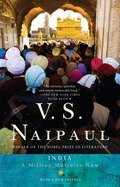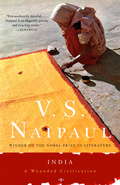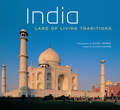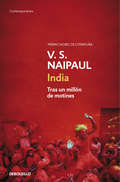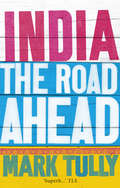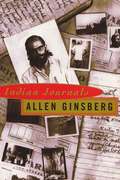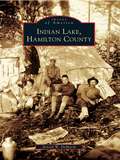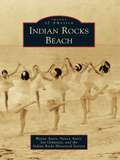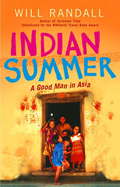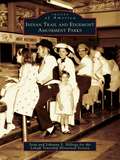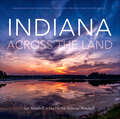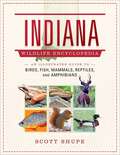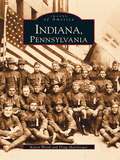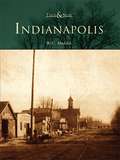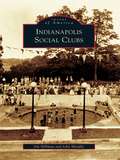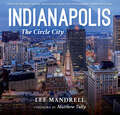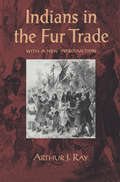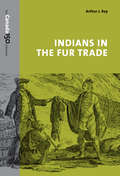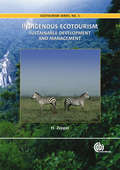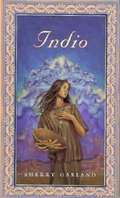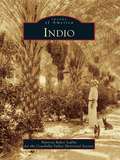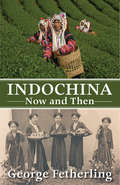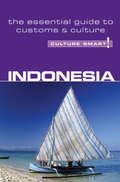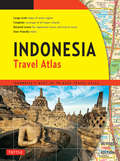- Table View
- List View
India: A Million Mutinies Now (Vintage International)
by V. S. NaipaulA New York Times Notable BookNobel laureate V. S. Naipaul’s impassioned and prescient travelogue of his journeys through his ancestral homeland, with a new preface by the author. Arising out of Naipaul’s lifelong obsession and passion for a country that is at once his and totally alien, India: A Million Mutinies Now relates the stories of many of the people he met traveling there more than fifty years ago. He explores how they have been steered by the innumerable frictions present in Indian society—the contradictions and compromises of religious faith, the whim and chaos of random political forces. This book represents Naipaul’s last word on his homeland, complementing his two other India travelogues, An Area of Darkness and India: A Wounded Civilization.
India: A Wounded Civilization (Vintage International Ser.)
by V. S. NaipaulFrom the Nobel Prize-winning author comes a masterpiece of astonishing insight and candor about a society traumatized by centuries of foreign conquest and immured in a mythic vision of its past.&“Extraordinarily forceful.... Naipaul is an elegantly precise and exacting writer.&” –NewsweekIn 1975, at the height of Indira Gandhi&’s &“Emergency,&” V. S. Naipaul returned to India, the country his ancestors had left one hundred years earlier. Out of that journey he produced a vibrant, defiantly unsentimental portrait of India. Drawing on novels, news reports, political memoirs, and his own encounters with ordinary Indians—from a supercilious prince to an engineer constructing housing for Bombay&’s homeless—Naipaul captures a vast, mysterious, and agonized continent inaccessible to foreigners and barely visible to its own people. He sees both the burgeoning space program and the 5,000 volunteers chanting mantras to purify a defiled temple; the feudal village autocrat and the Naxalite revolutionaries who combined Maoist rhetoric with ritual murder. Relentless in its vision, thrilling in the keenness of its prose, India: A Wounded Civilization is a work of astonishing insight and candor.
India: Land of Living Traditions
by Michael Freeman Alistar ShearerEverywhere one looks in India, time-honored tradition meets twenty-first century head-on in a dizzying cocktail of intense impressions. India is a paradise for the curious, for the reverent, for the adventuresome, and this is beautifully captured in India: Land of Living Traditions.
India: Tras un millón de motines
by V. S. NaipaulEl Premio Nobel de Literatura, V.S. Naipaul, nos sumerge en un apasionado y clarividente diario de viaje por la India, su país natal. Trazada sin prejuicios ni sentimentalismos, la visión lúcida, tierna y sarcástica de la India que ofrece V. S. Naipaul es una representación viva de una sociedad compleja en la que la modernidad se teje sobre un fondo tradicional. El enfrentamiento entre musulmanes e hindúes, las transformaciones del papel de la mujer, la supervivencia de los antiguos rituales, la dinámica industrial cinematográfica, la nueva literatura, los cambios en la institución familiar y la permanencia del sistema de castas son aspectos que no escapan a la aguda mirada del Premio Nobel de literatura. Reseña:«Por la abundancia de talento, difícilmente puede existir un escritor en la actualidad que supere a V. S. Naipaul.»The New York Times
India: the road ahead
by Mark TullySince the Indian economy was liberated from bureaucratic, socialist controls in 1991, it has developed rapidly. A country once renowned for the backwardness of its industries, its commerce and its financial market is now viewed as potentially one of the major world economies of the twenty-first century. But there are many questions which need to be asked about the sustainability of this rapid economic growth and its effect on the stability of the country. Have the changes had any impact on the poor and marginalised? Can India's democracy contain the mounting resentment of those left out of the new economic order? Can a high growth rate be sustained with India's notoriously corrupt and inefficient governance? Can the development of its creaking infrastructure be speeded up? How is India going to feed itself unless agriculture is reformed?This timely book will answer these questions through interviews with industrialists and cricketers, God men and farmers, plutocrats and former untouchables. Full of fascinating stories of real people at a time of great change, it will be of interest to economists, business people, diplomats, politicians, as well as to those who love to travel and who take an interest in the rapid growth of one of the world's largest countries, and what this means to us in the West.
Indian Journals, March 1962 - May 1963: Notebooks, Diary, Blank Pages, Writings
by Allen Ginsberg"The leading poet of the Beat generation and late-twentieth century American letters, a spokesman for the antiwar generation, an icon of the counterculture, Allen Ginsberg led a movement that profoundly altered the American literary and cultural landscapes. Indian Journals collects Ginsberg's writing from a 1962-63 stay in India. It is wonderfully eclectic, visionary, at times intensely private, and always in possession of a hallucinatory clarity that affirms Ginsberg's truly great ability, as well as his ebullient spirit." "Indian Journals took half a decade to transcribe and edit; when it was originally published in 1970 it catalyzed a large movement of young Western pilgrims to explore India and Eastern thought. This new edition contains an updated and expanded section of newly discovered photographs taken by Ginsberg during his time spent in India. The perfect combination of text and images, Indian Journals is testimony to Ginsberg's passionate interest in Eastern religion and mysticism and contains the raw materials for some of his most important poems."--BOOK JACKET.Title Summary field provided by Blackwell North America, Inc. All Rights Reserved
Indian Lake, Hamilton County (Images of America)
by Arnold W. DemarshThe village of Indian Lake was formally founded in 1858, during a time when many small communities were springing up in the Adirondacks as a result of the lumber industry. In 1889, Dr. Thomas C. Durant established a branch of the Delaware and Hudson Railroad that connected Saratoga Springs and North Creek. Through the later part of the 19th century and early-20th century, the Adirondack Mountains became a paradise destination for the rich and famous. Indian Lake, which began as a stopover for Blue Mountain Lake and Raquette Lake, quickly grew into a tourist center in its own right because of its ideal location and beauty. Indian Lake, Hamilton County is a pictorial journey through the golden age of this region, a haven of beauty and nature.
Indian Rocks Beach (Images of America)
by Wayne Ayers Nancy Ayers Jan Ockunzzi Indian Rocks Historical SocietyAccording to legend, Indian Rocks got its name when Tocobaga Indians brought their ailing chief from inland Florida to drink from the area's sulfur springs, prized for their medicinal qualities. Their leader miraculously recovered, as the story goes, and the tribe returned each year to the place where large rocks surrounded the healing spring. The natural beauty of the barrier island that became Indian Rocks Beach was what attracted Harvey Hendrick to establish his homestead here in the mid-1890s. Years later, he recalled, "I liked the place, I thought it was the most beautiful place on God's green footstool, and I think so yet." The charm and character of this little seaside community is evident in these historic photographs, from the days when the old swing bridge was the center of activity, to the booming post-World War II era when tourists and residents proclaimed Indian Rocks Beach as their special place.
Indian Summer
by Will RandallWhile attempting to teach at an inner London comprehensive Will Randall is taken up by an elderly German woman who asks him to accompany her to India. Nothing ventured, he agrees and so begins a wonderful life-changing adventure. Set down in Puna (3 hours from Bombay) he begins work teaching English at a slum school. Most of the children are orphans or parentless (one lost his parents four years previously when his mother had let go of his hand at a railway station and he 'd boarded the wrong train ). When zamidars -slum barons - arrive and threaten to pull down the school Randall has to put on a fund-raising performance of the Indian epic The Ramayana in order to help the slum dwellers buy their own land. Meanwhile he's also been spotted by a Bollywood Director who persuades him to take the role of leading man in his new film.Will Randall is 'the teacher who travels' and, as in SOLOMON TIME, this is a funny and heart-warming account of how one man's enthusiasm and old-fashioned desire to do good have helped to preserve a community.
Indian Summer
by Will RandallWhile attempting to teach at an inner London comprehensive Will Randall is taken up by an elderly German woman who asks him to accompany her to India. Nothing ventured, he agrees and so begins a wonderful life-changing adventure. Set down in Puna (3 hours from Bombay) he begins work teaching English at a slum school. Most of the children are orphans or parentless (one lost his parents four years previously when his mother had let go of his hand at a railway station and he 'd boarded the wrong train ). When zamidars -slum barons - arrive and threaten to pull down the school Randall has to put on a fund-raising performance of the Indian epic The Ramayana in order to help the slum dwellers buy their own land. Meanwhile he's also been spotted by a Bollywood Director who persuades him to take the role of leading man in his new film.Will Randall is 'the teacher who travels' and, as in SOLOMON TIME, this is a funny and heart-warming account of how one man's enthusiasm and old-fashioned desire to do good have helped to preserve a community.
Indian Trail and Edgemont Amusement Parks (Images of America)
by Lehigh Township Historical Society Johanna S. Billings Sean BillingsIndian Trail and Edgemont Amusement Parks highlights the history of two legendary amusement parks in Lehigh Township. Unique images cover Indian Trail Park from its founding by Samuel and William Solliday in 1929 to its closing in 1984. Photographs of Edgemont Park recall its days as a trolley park, started by the Blue Ridge Traction Company. These images are sure to bring back memories of the rides, games, and thrills that kept people coming back year after year.
Indiana Across the Land
by Lee Mandrell DeeDee Niederhouse-MandrellThe captivating landscapes of America's heartland offer an inviting escape from the everyday in Indiana Across the Land. Although a road trip from the shores of Lake Michigan to the Ohio River could be accomplished in only six hours, photographers Lee Mandrell and DeeDee Niederhouse-Mandrell take readers the long way around the Hoosier state, embarking on a breathtaking journey across the seasons, down windswept dunes, through old-growth forests, over burbling creeks and yawning chasms, past icy lighthouses and worn-down barns, and into the southern cypress swamps. More than 140 photographs capture the beauty of the Indiana Dunes National Lake Shore, Ouabache State Park, Turkey Run State Park, Squire Boone Caverns, and many other landmarks and natural wonders, both well-known and rarely glimpsed.
Indiana Wildlife Encyclopedia: An Illustrated Guide to Birds, Fish, Mammals, Reptiles, and Amphibians (Wildlife Encyclopedias)
by Scott ShupeIncluded are over 700 color photographs, depicting the different species of mammals, reptiles, amphibians, birds, and fish, while offering over 600 range maps to show their territory, along with basic information for the biology of each animal, Indiana's wildlife has always played an important role in the history of human beings inhabiting the state. Although the state&’s wildlife is still an important resource for human consumption, wildlife is also increasingly important in today&’s culture for its intrinsic, aesthetic value. For many Hoosiers, the age-old traditions of hunting and fishing have been replaced by a desire to simply observe wildlife and experience nature. But most Indianans are largely unaware of the diversity of species inhabiting their state. This volume is intended to provide an introduction to the state&’s fresh water fishes, amphibians, reptiles, birds, and mammals. In Indiana Wildlife Encyclopedia, nationally known naturalist Scott Shupe has collected information on all the native wildlife that reside in the Hoosier State. The fifth in a series of state wildlife encyclopedias, this book will be a handy, usable, layman&’s guide to Indiana's native wildlife. Shupe includes the size, habitat, and abundance of each species located in the state. Whether you&’re a lover of the outdoors, photography, or are looking to learn more about your state, this comprehensive guide will teach you about the wonderful wildlife that covers the water, earth, and skies of Indiana.
Indiana, Pennsylvania
by Karen Wood Doug MacgregorNestled in the hills of scenic western Pennsylvania, the borough of Indiana is a center of learning and the seat of county government. Incorporated in 1816, the borough lies in the heart of the state's bituminous coal region. Indiana has been home to a wide variety of industries and businesses, from breweries and lumber companies to higher education and Christmas tree farms. Among thousands of successful families and individuals, Indiana is famous as the home of actor Jimmy Stewart, Gov. John S. Fishe, and author Ed Abbey.Indiana, Pennsylvania is a compilation of stunning photographs that reveal a historical community. Included in this valuable history are the secret connections to the Underground Railroad, the arrival of electricity and telephones, the first automobiles, and the last Civil War veteran. Indiana, Pennsylvania also features many parts of the borough that have vanished, such as Indiana's early buildings and most of the old downtown hotels.
Indianapolis
by W. C. MaddenInaugurated as the state capital in 1825, Indianapolis was patterned after the nation's capital and laid out on a mile-square grid with Monument Circle at its center. As the city grew and experienced the tumult of the Civil War, legislators decided to erect a monument to the war's fallen servicemen. In 1902, one of the world's most outstanding memorials was completed-the Soldiers and Sailors Monument. Surrounding Monument Circle, "The Circle City" gets its nickname from the prominence and historical significance of the central city structure. Throughout the years, Indianapolis has maintained its commitment to honoring the achievements of Hoosiers. This dedication to Indiana has given the capital its own rich history, told not only through monuments and memorials, but also through the architecture, parks, businesses, and people that make up the heart of Indianapolis. This new book documents the heroes and history of the city, using an impressive collection of vintage photographs from the late 1800s through the early 1900s juxtaposed against present-day images.
Indianapolis Social Clubs (Images of America)
by John Murphy Jim HillmanMore than banquet halls, golf courses, and swimming pools, social clubs were a haven for businessmen, politicians, and community leaders, offering respite from public scrutiny. Defining Indianapolis, the clubs were stoic agents of power and segregation, providing clear historical snapshots of Hoosier pomp and circumstance. The clubs did more than produce Olympic swimmers, world-class golfers, and tennis professionals; they were Indianapolis's multigenerational playgrounds. There were the politics and business dealings at the Columbia Club and the Indianapolis Athletic Club, the golfing, tennis, and formality of Woodstock, Meridian Hills, and other country clubs, and the family fun in the sun at Riviera, Devon, and Olympia. These organizations offered more than magical summers with family and friends; they were the places to be seen.
Indianapolis: The Circle City
by Lee MandrellA beautifully photographed tour of the Indiana capital from city streets to state fairs to the world’s biggest Christmas tree.Indianapolis shines like never before in this one-of-a-kind book filled with stunning images. Photographer Lee Mandrell showcases a Circle City of unique architecture and natural areas, outstanding museums, and historic landmarks. Readers will be drawn into the rich culture, history, and art of Indianapolis as well as all things modern.Stroll along the famous Canal Walk. Explore the largest children’s museum in the world. Wander through the city’s parks and enjoy beautiful seasonal displays. Marvel at the campuses of Butler University and IUPUI—and see the two hundred eighty-four-foot-tall Soldiers and Sailors Monument covered in lights and the world’s largest Christmas tree.“This book will inspire with joy and reverence a greater love of Indianapolis.” —Senator Dick Lugar
Indians in the Fur Trade
by Arthur RayFirst published in 1974, this best-selling book was lauded by Choice as 'an important, ground-breaking study of the Assiniboine and western Cree Indians who inhabited southern Manitoba and Saskatchewan' and 'essential reading for anyone interested in the history of the Canadian west before 1870.' Indians in the Fur Trade makes extensive use of previously unpublished Hudson's Bay Company archival materials and other available data to reconstruct the cultural geography of the West at the time of early contact, illustrating many of the rapid cultural transformations with maps and diagrams. Now with a new introduction and an update on sources, it will continue to be of great use to students and scholars of Native and Canadian history.
Indians in the Fur Trade: Their Roles as Trappers, Hunters, and Middlemen in the Lands Southwest of Hudson Bay, 1660-1870
by Arthur RayFirst published in 1974, this best-selling book was lauded by Choice as 'an important, ground-breaking study of the Assiniboine and western Cree Indians who inhabited southern Manitoba and Saskatchewan' and 'essential reading for anyone interested in the history of the Canadian west before 1870.' Indians in the Fur Trade makes extensive use of previously unpublished Hudson's Bay Company archival materials and other available data to reconstruct the cultural geography of the West at the time of early contact, illustrating many of the rapid cultural transformations with maps and diagrams. Now with a new introduction and an update on sources, it will continue to be of great use to students and scholars of Native and Canadian history.
Indigenous Ecotourism: Sustainable Development and Management
by Heather D. ZeppelDealing with indigenous ecotourism as a special type of nature-based tourism, Indigenous Ecotourism examines the key principles of this field through global case studies and analyzes the key factors for sustainable development.
Indio
by Sherry GarlandTeenage Ipa struggles to survive a brutal time of change as the Spanish begin the conquest of the native people along the Texas border.
Indio (Images of America)
by Patricia Baker Laflin Coachella Valley Historical SocietyLocated halfway between Los Angeles and Yuma, Arizona, Indio came into being as a railroad town in 1876 when the Southern Pacific Railroad completed this last link in its southern transcontinental route. Settling this arid land took ingenuity and courage, and Indio's early residents had both. In the 1930s, Indio became a mining town when 92 miles of tunnel were dug through its eastern mountains for the Los Angeles Aqueduct, the largest construction project in the United States during the Depression. World War II brought Gen. George Patton's Desert Tank Corps to train nearby and crowd into Indio for rest and relaxation. The completion of the Coachella Branch of the All-American Canal brought Colorado River water to the desert in the late 1940s, and a land boom ensued. Today Indio's reputation as the "Date Capital of the United States" and "City of Festivals" is long held and well deserved.
Indochina Now and Then
by George FetherlingFollow George Fetherling as he travels through Vietnam, Laos, and Cambodia looking for any remaining traces of the Indochina that was. In Indochina Now and Then, George Fetherling recounts multiple journeys through Vietnam, Laos, and Cambodia, keeping an eye peeled and an ear cocked for whatever faint traces of French rule might remain. While doing so he searches diligently in village markets, curio shops, and rubbish bins, not to mention bookstalls along the Seine in Paris, for early picture postcards of Southeast Asia, the sort that native Frenchmen and Frenchwomen sent home to Europe. The book is illustrated with 60 such images, most of them taken before the First World War. They evoke vanished ways of life in these exotic "lands of charm and cruelty" that have survived the wars and turmoil of the late 20th century to emerge, smiling enigmatically, as the friendly face of free-market socialism. In its prose and pictures, Indochina Now and Then is a travel narrative that will leave an indelible impression in the reader’s imagination.
Indonesia - Culture Smart!
by Graham SaundersCulture Smart! provides essential information on attitudes, beliefs and behavior in different countries, ensuring that you arrive at your destination aware of basic manners, common courtesies, and sensitive issues. These concise guides tell you what to expect, how to behave, and how to establish a rapport with your hosts. This inside knowledge will enable you to steer clear of embarrassing gaffes and mistakes, feel confident in unfamiliar situations, and develop trust, friendships, and successful business relationships. Culture Smart! offers illuminating insights into the culture and society of a particular country. It will help you to turn your visit-whether on business or for pleasure-into a memorable and enriching experience. Contents include * customs, values, and traditions* historical, religious, and political background* life at home* leisure, social, and cultural life* eating and drinking* do's, don'ts, and taboos* business practices* communication, spoken and unspoken "Culture Smart has come to the rescue of hapless travellers." Sunday Times Travel "... the perfect introduction to the weird, wonderful and downright odd quirks and customs of various countries." Global Travel "...full of fascinating-as well as common-sense-tips to help you avoid embarrassing faux pas." Observer "...as useful as they are entertaining." Easyjet Magazine "...offer glimpses into the psyche of a faraway world." New York Times
Indonesia Travel Atlas Third Edition
by Periplus EditorsFinding your way around the various regions of Indonesia is a breeze with this handy Tuttle Travel Atlas. Designed for the adventurous traveler and containing all the maps you'll need on your explorations, this atlas includes many views that are available nowhere else.This Atlas is conveniently divided into the major regions of Indonesia: Jakarta, West Java, Central Java, East Java, Bali, Nusa Tenggara, Sumatra, Kalimantan, Sulawesi, Maluku and Papua. Each of the 144 maps in this atlas is presented in a logical, easy-to-follow manner, with emphasis on the most frequently-visited areas. All cities, towns, villages, places of interest and nature reserves are indexed for quick reference.Comprehensive: Detailed insets of major cities, travel destinations and business hubs in IndonesiaInformative: Precise locations of all popular sights, hotels, restaurants, temples, shopping malls and other essential locations.Practical: The handy size, well-designed key maps and comprehensive index help you find places you are looking for quickly.Reliable: The maps in this atlas are thoroughly researched and regularly updated by the leading publisher of Asia Pacific maps.
